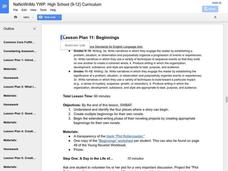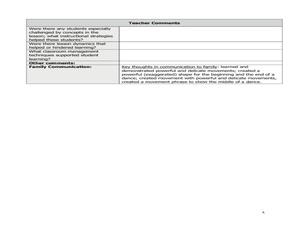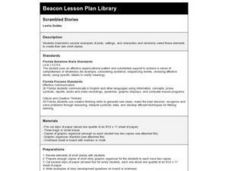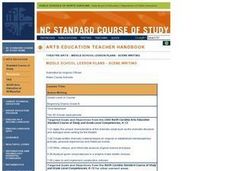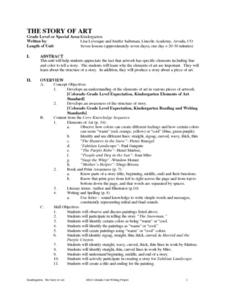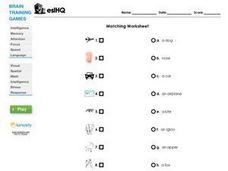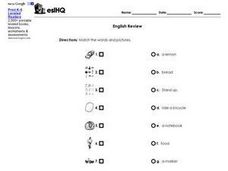Curated OER
Marking Time
Two narrative excerpts tell the same story from different points of view. In the first excerpt (first person), sequencing words and phrases are bolded and learners write down what the bold type does. The second excerpt is in third...
Curated OER
Lesson Plan 11: Beginnings
Every good novel needs a solid beginning! Setting the stage can have your budding authors stumped, so use this lesson to get them thinking. After examining the plot rollercoaster image (included) they consider the four places their story...
Curated OER
Dance and Writing
Fourth graders use dance moves to perform narratives. In this dramatic performing lesson, 4th graders use strong and soft movements to show what character's voice is portraying. Students also use movement to show the feelings in the...
Curated OER
Martin Luther King Jr.
After listening to a story about Martin Luther King Jr., first graders answer questions about the text. They discuss the importance of the illustrations, identify the beginning, middle, and end of the story, and complete a writing...
Curated OER
Writing: Mentor Text Lesson & Microteaching
Mentor texts are a great way to demonstrate how to write with purpose. Pupils will be reintroduced to two well-known books and then asked to think about them from the writer's point of view. They will see that the author had to use basic...
Curated OER
Crater Creation
After looking at the back of a quarter featuring Oregon terrain, learners distinguish between fiction and non-fiction and identify the beginning, middle and end of a story. First, they listen to legends that describe the creation of...
Creative Visions Foundation
Developing a Structure for Documentaries
Provide some group brainstorming and story-planning time with the fifth lesson in a series on examining and creating documentaries. After you've explained the purpose of each section of a documentary, groups meet to plan the beginning,...
Curated OER
Story Stick Medallions
Students identify and visually represent important events in the beginning, middle, and end of a story. They arrange the pictures in sequential order. Students verbalize details while they retell their story idea to friends and family...
Curated OER
Scrambled Stories
Character development, setting, and plot? Sounds like the makings of a good narrative story. Young authors read and analyze several narrative examples, and then they use what they know to pen an original composition. They work both in...
Curated OER
The World Around Me
Combining visual and language arts, here is a resource that prompts middle schoolers to write stories based on pictures of their surroundings. They use digital cameras to take pictures of favorite areas in the school. Next, they choose...
Curated OER
Zigzag
Students observe three boxes drawn on the board to organize a story's beginning, middle, and end. They listen to the story Zigzag and identify a beginning, middle and end to organize their thoughts sequentially to improve recall.
Curated OER
Roboteacher
Present this slide show to your class and see what they think. It's the story of Roboteacher, obviously written and perhaps illustrated by a student. It could be used to reinforce story boarding, story telling, story retell, or creative...
Curated OER
Elmer by David McKee
Students explore individual differences. For this literacy and self-esteem lesson, students listen to the story Elmo by David McKee, then describe what characteristics make Elmo special. Students complete a T chart showing how Elmo...
Curated OER
Latin Roots Dict, Vent, Duct: Beginning Quiz
Learners fill in the blanks for 12 sentences with words derived from the Latin roots dict, vent, and duct in an interactive online quiz. A word bank provides choices from the beginning level at MyVocabulary.com. Alert quiz takers that...
Curated OER
ESL: Around Town Matching
Tiny pictures of buildings found around town can be matched with their names in this exercise for beginning English Learners. Indefinite articles are included with vocabulary; nice way to reinforce the "a/an" rule. Pictures are quite...
Curated OER
ESL: Body Parts Matching
Match drawings of basic body parts with their names. A handy tool for teachers of beginning ELLs.
Curated OER
Rhythmic Expression
Learners discover movement and expression to music/sound through a series of teacher-led exercises and role plays. This lesson is ideal for the middle school drama class with possibilities for adaptation to any level of drama or general...
Curated OER
Starting at the Beginning
Sixth graders develop basic band skills through in-class instruction, individual practice, and the Essential Elements band method. Instruction is teacher-led with examples and drill/practice. National Standards for the arts are...
Curated OER
Scene Writing
Eighth graders create an original scene or short one-act play within specified guidelines. Assessment is based upon the performance of student-created scenes during class time. Rubrics for assessment and connection to state standards...
Curated OER
The Story of Art
Students canvass the important elements of art in the seven lessons of this unit. Story structure and in particular, color is perceived as essential to the development of the idea of a picture.
Curated OER
ESL: Beginning Vocabulary Matching
Beginning English Learners match 10 line-drawn pictures of basic nouns with their names, such as kite, airplane, goat, and igloo. Indefinite articles are included, so this exercise also provides reinforcement for the a/an rule.
Curated OER
ESL: Basic Vocabulary Matching
Newcomers to English can practice vocabulary about food, daily actions, and school supplies with this 10-question matching exercise. Simple line drawings represent basic terms for beginners.
Curated OER
Beginning and End
Are you working onevent sequence in your kindergarten class? Use a reading activity to have your kids discuss events from the story, and put them in order. They then cut and paste them in the correct order. A great project for any story!
Curated OER
Monitoring Comprehension Progress: Story Retells
Learners retell a story by filling out a record sheet. In this retelling lesson plan, students fill out a record sheet that gives them prompts about the beginning, middle, and end of a story.



